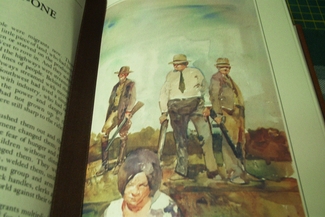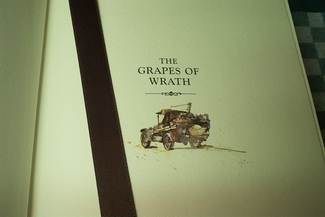The Grapes of Wrath is a classic American novel written by John Steinbeck, published in 1939. The book is set during the Great Depression and follows the Joad family as they embark on a journey from the dust bowl-ridden fields of Oklahoma to California in search of a better life. The novel is a powerful exploration of social, economic, and environmental issues, and it remains one of the most significant works of American literature.
In the dust-choked heart of Oklahoma, where the land itself seemed to wither and crumble beneath the relentless sun, the Joad family gathered their belongings, dreams, and the weight of despair. Tom Joad, freshly released from prison, returned to a home transformed by the cruelty of the Dust Bowl and economic ruin. Their farm, like countless others, had succumbed to the merciless forces of nature and greed. As the Joads set forth on Route 66 in a dilapidated truck loaded with their meager possessions, John Steinbeck began weaving a tale that would resonate across generations. The road stretched before them, an uncertain path leading westward to the promised land of California. Ma Joad, the indomitable matriarch, held the family together with an unwavering spirit, embodying resilience in the face of adversity.
Their journey was more than a physical migration; it became a metaphorical odyssey through the heart of America's social and economic struggles during the Great Depression. The landscape they traversed mirrored the desolation within, echoing the collective hardships of those displaced by environmental catastrophe and economic collapse.
In California, the Joads found not the utopia they had envisioned, but a harsh reality where opportunities were scarce, wages paltry, and hope fleeting. The once verdant fields of the promised land were now barren, and the allure of prosperity was a mirage for the multitude of desperate families seeking refuge.
The Grapes of Wrath unveiled a society plagued by inequality and exploitation. Large agribusinesses, symbolized by the faceless owners of vast orchards, reaped the fruits of others' labor while the migrant workers, including the Joads, toiled under deplorable conditions for meager wages. The grapes, a symbol of plenty, became bitter reminders of the harsh truth – the abundance of the land was not meant for those who worked it. Tom Joad, the novel's central figure, transformed from a disillusioned ex-convict into a symbol of resistance. His journey mirrored the awakening of a collective consciousness among the disenfranchised. The struggle for dignity and justice resonated in his interactions with fellow migrants, as they began to question the social order that oppressed them.
The Joad Family
The story revolves around the Joads, a poor family of tenant farmers who lose their land due to the Dust Bowl and economic hardships. The family is led by Tom Joad, who has just been released from prison, and his parents, Ma and Pa Joad.The Dust Bowl
The novel is set against the backdrop of the Dust Bowl, a severe environmental disaster that affected the Great Plains during the 1930s. The harsh conditions and crop failures led to widespread poverty and forced many families, like the Joads, to migrate in search of work and a better life.The Journey to California
The Joads, like many other families, set out for California, which was believed to offer jobs and opportunities for a better life. The journey is fraught with challenges, and the family faces hardships, discrimination, and exploitation along the way.Social Injustice and Exploitation
Steinbeck's novel vividly depicts the exploitation of migrant workers in California, where large agricultural corporations took advantage of the desperate and impoverished newcomers. The novel highlights the inequality and injustice faced by the working class during the Great Depression.Themes of Resilience and Solidarity
Despite the hardships, the Joad family demonstrates resilience and solidarity. The novel explores the strength of familial bonds and the human spirit in the face of adversity.Symbolism
The title of the novel is derived from the lyrics of "The Battle Hymn of the Republic," and the grapes become a powerful symbol of oppression and exploitation. The novel is rich with symbolism, capturing the broader social and political themes of the time.The Grapes of Wrath received widespread critical acclaim and won the Pulitzer Prize for Fiction in 1940. It remains a classic piece of American literature, known for its social commentary, memorable characters, and evocative depiction of the challenges faced by ordinary people during a tumultuous period in American history. The Grapes of Wrath painted a searing portrait of the human spirit, unyielding in the face of hardship. Steinbeck's prose, both poetic and raw, captured the essence of a nation in crisis. The novel remains a timeless exploration of the enduring human quest for justice, dignity, and the elusive promise of a better life.




Comments
Post a Comment
Share your best book review and recommendation